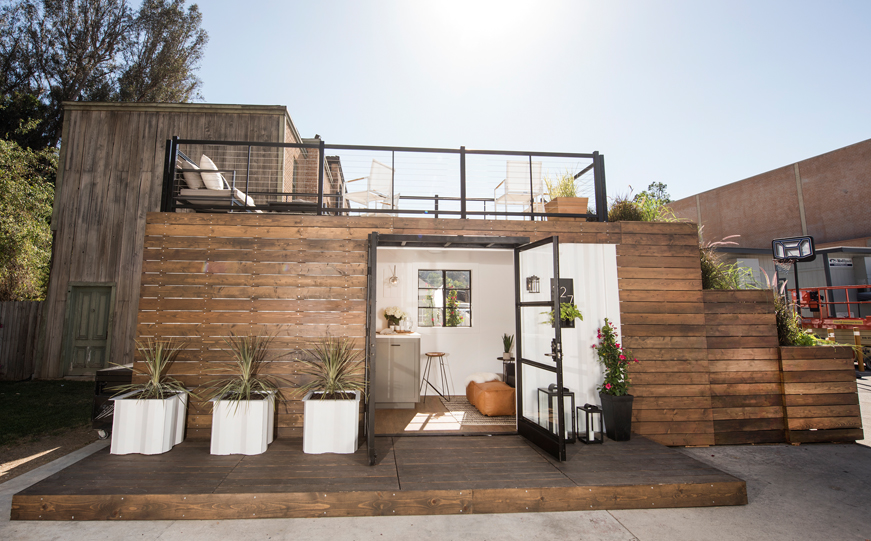Designer and television host Kelly Edwards and contractor Art Steedle joined forces on a new business venture called Cargo Builders. For this container home, Kleber & Associates arranged for a product placement for Feeney’s DesignRail to be utilized in this luxurious rooftop outdoor room. Photo Credit: Josh Roth
America is downsizing in a big way. One of the most notable trends of the last year is the “tiny house” movement. Characterized by tiny (as in, just a few hundred square feet tiny) houses that are often mobile, it’s a trend favored by people who prioritize outdoor living and travel over “stuff.” They see these miniscule abodes as a way to break from the shackles of a huge mortgage and live happier, simpler lives. For their diminutive size, tiny homes have a lot to love. They go hand-in-hand with an appealing, active lifestyle. They are typically well-appointed. They are efficient and cozy. And let’s face it: they’re irresistibly cute.
If we’re honest with ourselves, there is a small part of each of us that yearns to live the carefree, tiny home lifestyle. Tiny homes are also getting big media attention. There are even tiny home communities being developed. But will tiny homes turn into a big trend, causing sprawling suburbs to dwindle? Not likely. Love ‘em or hate ‘em, big houses in the leafy suburbs aren’t going anywhere, according to a study by the Urban Land Institute. The study found that 79 percent of the population of the largest cities live in the suburbs, and that metropolitan growth is being driven by suburban growth.
Perhaps most surprising, even millennials are choosing to live in the suburbs over the cities by a shocking three-to-one margin. And you can bet there’s nothing tiny about houses in these suburbs. But just because the tiny home trend is not likely to catch on to the mainstream, it most certainly will have an effect on homes and home products. As it almost always happens in these situations, a trend will leave pieces of itself behind after it’s gone. What will those tidbits be? We can’t say for sure (if we could, we’d be writing this on our tiny house in the Caribbean instead of the American Southeast). But we do have some educated guesses:
Sustainability/Energy Efficiency This is hardly a new trend, but the tiny home movement has further advanced the notion that homes should have a small impact on the environment (and on your utility bills), no matter what their square footage. Smart marketers will see tiny homes as the benchmark, and develop and market products that squeeze more efficiency out of every energy dollar, and use sustainable products.
Quality vs. Size/Price A key aspect of the tiny home movement is that they are built well, using high-quality materials. This may lead homeowners — even those in “big” houses — to value well-built products that are “right-sized” in terms of size and cost.
Ease of Ownership One of the best things tiny homes have going for them is there is not much to clean and maintain. You can practically pick them up and dump out any dirt and dust. So products that are truly low- or no-maintenance, or that reduce the time necessary to keep the home ship-shape, will certainly gain consumers’ attention.
Outdoor Living Tiny homes are good for cooking, sleeping, and, well, using the bathroom. Aside from that, much of the “living” needs to be done outside. Products that make it easier to enjoy the outdoors — while still letting people retreat inside when the weather turns foul — will catch the attention of homeowners not ready to give up their walk-in closets and bonus rooms.
Decentralization This is a big one for tiny home dwellers. As efficient as their homes are, they invariably have some things that simply don’t fit. Bikes, snowboards, motorcycles. Some tiny home developments solve this with shared storage facilities. Why can’t this concept apply to regular-sized homes? What other functions of the home can be taken off-site and shared with neighbors?
Smart Space Use Boat designers have known for a long time what tiny home builders are now figuring out: a little creativity goes a long way when it comes to space utilization. Well-designed, space-saving products and storage solutions are appreciated in any home, tiny or otherwise. — Certainly, other trends from the tiny home movement will “stick.” For home products marketers, the challenge will be to capture the spirit of the tiny home trend movement while still giving people some space. That will require them challenge conventions and rethink their products in entirely new ways.




